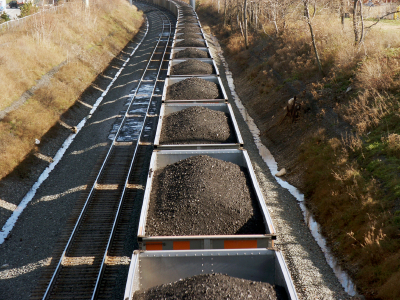 A massive new rail line planned to move millions of tons of low-grade coal from northeastern Wyoming to the Midwest has been stopped. For more than nine years Sierra Club and our allies have been battling plans by Dakota Minnesota & Eastern Railroad Corp. (DM&E) to build this new coal line, and late yesterday DM&E announced the project is “on hold.”
A massive new rail line planned to move millions of tons of low-grade coal from northeastern Wyoming to the Midwest has been stopped. For more than nine years Sierra Club and our allies have been battling plans by Dakota Minnesota & Eastern Railroad Corp. (DM&E) to build this new coal line, and late yesterday DM&E announced the project is “on hold.”
The $6 billion rail line would have carried 100 million tons of coal annually, enough to power about 50 coal plants. If burned, the coal shipped by this rail line alone would have emitted approximately 200 million tons of carbon dioxide, the equivalent of adding about 40 million cars to our highways. By stopping this coal line we are ever closer to averting runaway global warming and jump-starting a clean energy revolution.
Let’s put those numbers in perspective. Stopping this one rail line may be one of the biggest steps we have ever taken to slow global warming. For the U.S. to do its part to stop global warming, we have to reduce our carbon run-rate by upwards of 200 million tons each year. This one victory has thus bought us a full year’s worth of progress – not that we should stop here, of course.
This decision is also further evidence that coal is on its way out. The risk of financing coal ventures, future carbon regulations, the Obama Administration closing the loopholes coal enjoys in mining, burning and ash disposal, and competition from affordable and reliable clean energy options clearly spells trouble for coal.
The Sierra Club beat back this project in 2002 when we and our allies persuaded the U.S. Court of Appeals for the Eighth Circuit that the Bush Administration had failed to consider the global warming impacts of this new train line. This decision stands as one of the first global warming cases in our nation. After the Bush Administration agreed this project might have some impact on global warming, the legal challenges continued.
Throughout the years of legal wrangling we worked with a broad coalition of landowners and public health advocates — including the Mayo Clinic in Rochester — who did not want coal trains running through their back yards.
Stopping this ill-conceived coal line continues a welcome and recent trend. In just the past few weeks we’ve seen decisions not only to abandon plans for new coal plants, but we’ve also seen existing coal plants being retired and replaced with cleaner alternatives.
Last week Ohio Edison Co. announced it would slash coal burning at its R.E. Burger coal plant in Shadyside, Ohio, and replace the coal with biomass due to a pollutant-lowering agreement with the U.S. Environmental Protection Agency.
This past Monday, Tennessee Valley Authority (TVA) entered the twentieth century when it announced that it will study whether it should close the John Sevier coal plant in Rogersville, Tenn., and six units of its Widows Creek Fossil Plant in Stevenson, Alabama.
Just one day later, Progress Energy made public plans to close three coal plants in North Carolina. The coal plants would be replaced with a clean-burning natural gas power plant. Progress Energy cited “changing emission targets and the likelihood of legislation to reduce carbon emissions” as a reason for the switch.
This week we also celebrated the 101st proposed coal plant being defeated. For more than a year we, along with our allies, have been battling Santee Cooper’s planned Pee Dee coal plant in South Carolina. Apparently someone at Santee Cooper finally updated the cost of coal and realized that global warming regulation was imminent.
All that, and we can see why the Energy Information Administration (EIA) announced recently that coal use in the United States has plummeted in the past year. Whereas coal provided more than 55 percent of our electricity in May 1985, in May of this year it only provided 42.5 percent of U.S. electricity. It’s a welcome downward trend for coal, and we will be doing everything we can to replace the remaining dirty coal with clean energy even faster in the future.


